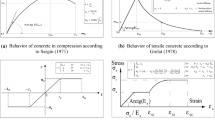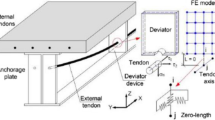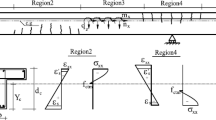Abstract
This paper presents an analytical model for the short- and long-term analysis of composite steel-concrete beams with partial shear interaction and accounting for shear-lag effects. The material properties of the concrete have been assumed to be time-dependent and have been modelled by means of the algebraic methods while the remaining materials forming the cross-section have been supposed to behave in a linear-elastic manner. The global balance condition of the problem has been obtained by means of the principle of virtual work and, integrating this by parts, the governing system of differential equations and corresponding boundary conditions have been determined. Analytical expressions for both short- and long-term solutions have been derived and, to outline their ease of use, a number of case studies relevant for bridge applications have been proposed.
Similar content being viewed by others
References
Adekola, A. O. (1974). “The dependence of shear-lag on partial interaction in composite beams.”International Journal of Solids and Structures, 10, pp. 389–400.
Amadio, C. and Fragiacomo, M. (1993). “A finite element model for the study of creep and shrinkage effects in composite beams with deformable shear connections.”Costruzioni Metalliche, 4, pp. 213–228.
Ayoub, A. (2005). “A force-based model for composite steel-concrete beams with partial interaction.”Journal of Constructional Steel Research, 61, pp. 387–414.
Bažant, Z. P. (1972). “Prediction of concrete creep effects using age-adjusted effective modulus method.”ACI Journal, 69(4), pp. 212–217.
Bradford, M. A. (2010). “Generic modelling of composite steel-concrete slabs subjected to shrinkage, creep and thermal strains including partial interaction.”Engineering Structures, 32, pp. 1459–1465.
Bradford, M. A. and Gilbert, R. I. (1992). “Composite beams with partial interaction under sustained loads.”Journal of Structural Engineering, 118(7), pp. 1871–1882.
CEB (Comit Euro-International du Béton) (1984).CEB Design manual on structural effects of time-dependent behaviour of concrete. Edited by Chiorino, M.A., Napoli, P., Mola, F. and Koprna, M., Georgi Publishing, Saint-Saphorin, Switzerland.
Choi, D. H., Kim, Y. S., and Yoo, H. (2008). “External post-tensioning of composite bridges by a rating equation considering the increment of a tendon force due to live loads.”International Journal of Steel Structures, 8(2), pp. 109–118.
Dall’Asta, A. and Zona, A. (2002). “Non-linear analysis of composite beams by a displacement approach.”Computers & Structures, 80, pp. 2217–2228.
Dezi, L., Gara, F., Leoni, G., and Tarantino A. M. (2001). “Time dependent analysis of shear-lag effect in composite beams.”Journal of Engineering Mechanics, 127(1), pp. 71–79.
Dezi, L., Leoni, G., and Tarantino, A. M. (1995). “Time-dependent analysis of prestressed composite beams.”Journal of Structural Engineering, 121(4), pp. 621–633.
Dezi, L., Leoni, G., and Tarantino, A. M. (1996). “Algebraic methods for creep analysis of continuous composite beams.”Journal of Structural Engineering, 122(4), pp. 423–430.
Fabbrocino, G., Manfredi, G., and Cosenza, E. (2001). “Ductility of composite beams under negative bending: an equivalence index for reinforcing steel classification.”Journal of Constructional Steel Research, 57, pp. 185–202.
Gara, F. (2000).Shear-lag, connection deformability and creep effects in steel-concrete composite beams. Ph.D. thesis in Structural Mechanics, University of Bologna, Italy.
Gara, F., Leoni, G., and Dezi, L. (2009). “A beam finite element including shear lag effect for the time-dependent analysis of steel-concrete composite decks.”Engineering Structures, 31, pp. 1888–1902.
Gara, F., Ranzi, G., and Leoni, G. (2008). “Analysis of the shear lag effect in composite bridges with complex static schemes by means of a deck finite element.”International Journal of Steel Structures, 8, pp. 249–260.
Gara, F., Ranzi, G., and Leoni, G. (2006). “Time analysis of composite beams with partial interaction using available modelling techniques: A comparative study.”Journal of Constructional Steel Research, 62, pp. 917–930.
Gilbert, R. I. and Ranzi, G. (2011).Time-dependent behaviour of concrete structures. Spon Press, London, UK.
Johnson, R. P. and Molestra, I. N. (1991). “Partial shear interaction in composite beams for buildings.”Proc. the Institution of Civil Engineers, Part 2, 91, pp. 679–704.
Kim, S. H., Ahn, J. H., Jung, C. Y., and Kim J. H. (2009). “Multi-stepwise thermal prestressing using a cover-plate in steel structures.”Journal of Constructional Steel Research, 65, pp. 1464–1479.
Kim, S. H., Kim J. H., Jung, C. Y., and Ahn, J. H. (2010). “Life-cycle cost analysis of a TPSM applied continuous composite girder bridge.”International Journal of Steel Structures, 10(2), pp. 115–129.
Kroflic, A., Planinc, I., Saje, M., Turk, G., and Cas, B. (2010). “Non-linear analysis of two-layer timber beams considering interlayer slip and uplift.”Engineering Structures, 32, pp. 1617–1630.
Kwak, H. G. and Seo, Y. L. (2002). “Time-dependent behaviour of composite beams with flexible connectors.”Computer Methods in Applied Mechanics and Engineering, 191, pp. 3751–3772.
Macorini, L., Fragiacomo, M., Amadio, C., and Izzuddin, B. A. (2006). “Long-term analysis of steel-concrete composite beams: FE modelling for effective width evaluation.”Engineering Structures, 28, p. 1110–1121.
Newmark, N. M., Siess, C. P., and Viest, I. M. (1951) “Tests and analysis of composite beams with incomplete interaction.”Proc. the Society of Experimental Stress Analysis, 9(1), pp. 75–92.
Nie, J., Cai, C. S., and Wang, T. (2005). “Stiffness and capacity of steel-concrete composite beams with profiled sheeting.”Engineering Structures, 27, pp. 1074–1085.
Oven, V. A., Burgess, I. W., Plank, R. J., and Wali, A. A. A. (1997). “An analytical model for the analysis of composite beams with partial interaction.”Computers & Structures, 62. pp. 493–504.
Pi, Y. L., Bradford, M. A., and Uy, B. (2006). “Second Order Nonlinear Inelastic Analysis of Composite Steel-Concrete Members.” I: Theory.Journal of Structural Engineering, 132, pp. 751–761.
Planinc, I., Schnabl, S., Saje, M., Lopatic, J., and Cas, B. (2008). “Numerical and experimental analysis of timber composite beams with interlayer slip.”Engineering Structures, 30, pp. 2959–2969.
Ranzi, G. (2008). “Locking problems in the partial interaction analysis of multi-layered composite beams.”Engineering Structures, 30, pp. 2900–2911.
Ranzi, G. and Bradford, M. A. (2009). “Analysis of composite beams with partial interaction using the direct stiffness approach accounting for time effects.”International Journal for Numerical Methods in Engineering, 78, pp. 564–586.
Ranzi, G., Dall’Asta, A., Ragni, L., and Zona, A. (2010). “A geometric nonlinear model for composite beams with partial interaction.”Engineering Structures, 32, pp. 1384–1396.
Ranzi, G. and Zona, A. (2007). “A steel-concrete composite beam model with partial interaction including the shear deformability of the steel component.”Engineering Structures, 29, pp. 3026–3041.
Schnabl, S., Planinc, I., Saje, M., Èas, B., and Turk, G. (2006). “An analytical model of layered continuous beams with partial interaction.”Structural Engineering and Mechanics, 22, pp. 263–278.
Shim, C. S. and Kim, D. W. (2010). “Structural performance of composite joints using bent studs.”International Journal of Steel Structures, 10(1), pp. 1–13.
Sousa Jr, J. B. M., Oliveira, C. E. M., and da Silva, A. R. (2010). “Displacement-based nonlinear finite element analysis of composite beam-columns with partial interaction.”Journal of Constructional Steel Research, 66, pp. 772–779.
Sun, F. F. and Bursi, O. (2005). “Displacement-based and two-field mixed variational formulation for composite beams with shear lag.”Journal of Mechanical Engineering, 131(2), pp. 199–210.
Tarantino, A. M. and Dezi, L. (1992). “Creep effects in composite beams with flexible shear connectors.”Journal of Structural Engineering, 118, pp. 2063–2081.
Trost, H. (1967). “The implications of the principle of superposition for creep and relaxation problems of concrete and prestressed concrete.”Beton- und Stahlbetonbau, 10, pp. 230–238 (In German).
Won, J. H., Wu, J. X., Davaadorj, A., Kim, S. H., and Mha, H. S. (2008). “Seismic behaviour analysis of a plate-girder bridge considering abutment-soil interaction.”International Journal of Steel Structures, 8, pp. 285–294.
Zona, A., Barbato, M., Dall’Asta, A., and Dezi, L. (2010). “Probabilistic analysis for design assessment of continuous steel-concrete composite girders.”Journal of Constructional Steel Research, 66, pp. 897–905.
Author information
Authors and Affiliations
Corresponding author
Additional information
Discussion open until May 1, 2011.
Rights and permissions
About this article
Cite this article
Gara, F., Ranzi, G. & Leoni, G. Short- and long-term analytical solutions for composite beams with partial interaction and shear-lag effects. International Journal of Steel Structures 10, 359–372 (2010). https://doi.org/10.1007/BF03215844
Received:
Accepted:
Issue Date:
DOI: https://doi.org/10.1007/BF03215844




